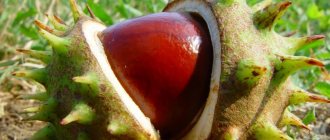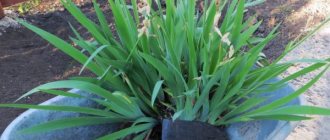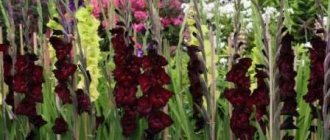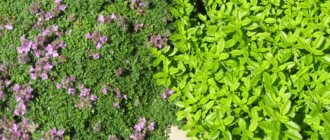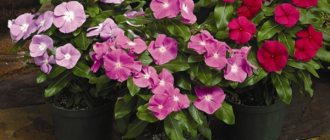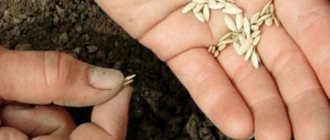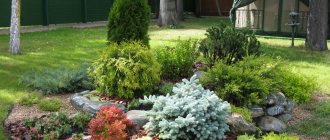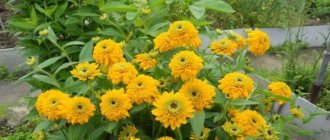Description of the western thuja
This is a slowly growing tree, reaching a height of 15-20 m, although taller specimens are also found in nature, but this is already rare. The crown of the western thuja is pyramidal or ovoid, while that of the original species is rather spreading. The root system is compact.
The bark at a young age is brick-brown, smooth, over time it becomes gray-brown; in a tree with more than ten years of history, the bark on the trunk has deep longitudinal cracks and is fibrous.
The needles of the thuja are scaly, green and very small, 2-4 mm long, covering the branches like scales. The lifespan of the foliage is a maximum of 2-3 years, then it falls off, but not one at a time, but in small branches, the crown is renewed gradually and imperceptibly. By winter, the needles discolor to yellowish-green or brown. The concept of “evergreen plant” for thuja is relative; if spruce or pine do not change the shade of their needles at all in winter, then most varieties of western thuja paint the garden yellow-brownish or light green.
The flowers are not decorative - monoecious, apical, solitary. The cones are also small, about 1 cm long, ovoid in shape. Each cone contains two yellow winged seeds.
The wood when cut is reddish in color, often interspersed with brown, yellow and red veins. The wood is soft and durable, does not contain resin, does not rot and could be an excellent furniture material, but is not widely used - this is hampered by the too slow growth of mass and the fibrousness of the bark.
Peculiarities
Thuja is very popular not only in private gardens, but is also widely used for urban landscaping, since the plant is extremely unpretentious to the ecology of the city: it tolerates gas pollution, dust and smoke well. It takes root easily after transplantation, lends itself well to pruning and shearing; some varieties do not require shape correction at all - they grow on their own in a pyramid, ball or cone. In addition, the western thuja and its varieties are winter-hardy (frost hardiness zones from 2b to 8b, this is approximately down to minus 36°C in winter without shelter).
How to care for thuja after planting
This shrub can be classified as an unpretentious crop with simple agricultural cultivation techniques. However, it still needs minimal care, especially during the first time after planting in spring and summer in a permanent place in the garden. To properly care for thuja in the open ground, you need to follow simple rules:
- Watering should be done regularly, approximately once a week, using 3-4 buckets per bush, more often in hot and dry weather. This crop loves sprinkling, it needs to be done periodically, especially in hot and dry times, but sprinkling should be done strictly early in the morning or in the evening, when the sun has set.
- If the soil settles after planting after some time, then you need to fill up the soil to the previous level.
Advice! After spring planting, the shrub is under stress and is especially vulnerable. Therefore, it is very important to protect thuja from bright sunlight. To do this, you need to put some kind of frame around it, for example, arches, and stretch burlap or agrofibre for the first time (about 1-2 weeks). In this case, the covering material should be nearby, but not in any way contact with the plant itself!
- Mulching is very useful for any shrub. It keeps the soil moist for a long time and protects the roots from overheating. As noted above, you can mulch with pine litter, pine bark, and peat. The thickness of the mulch is 7-10 centimeters.
- If you are mulching, then you need to loosen the soil around the tree trunk . Loosening is recommended to be done after watering or rain to a depth of 5 centimeters.
- It is necessary to weed out weeds ; they must not be allowed to grow.
- If you filled the hole well before spring planting, then in the first 6-12 months you don’t have to worry about feeding. Afterwards, you can use special fertilizers for conifers.
- Shelter in the fall before the winter cold is very important; it will protect the plants from cold and bad weather. First of all, you need to cover the root system, that is, mulch it (a layer of about 10 cm). In the first year, it is recommended to cover small seedlings with a trimmed 5-liter bottle. More mature plants can be wrapped in agrofibre (it protects from wind and partially from ultraviolet radiation). But materials that completely do not transmit light cannot be used, because thuja is an evergreen plant and photosynthesis processes take place all year round.
Varieties and varieties of thuja occidentalis
Western thuja has several decorative forms:
- weeping
- columnar (pyramidal)
- hemisphere
- spherical
According to the color of foliage (needles) of the variety:
- variegated (several color variations)
- with green leaves
By tallness:
- full-grown from 5 m or more
- semi-dwarf from 3 to 5 m
- dwarf – mature trees up to 3 m
- miniature – less than 3 m tall
In terms of frost resistance: there are varieties that easily tolerate winters in central Russia, and there are varieties that require mandatory shelter.
Here are some frost-resistant ones:
- Danica (Danica) is a miniature variety up to 60 cm or slightly higher in height, spherical in shape, winter hardiness - climate zone 3.
- Globosa is a spherical miniature thuja, an adult no more than 2 m, grows very slowly, winter hardiness - climate zone 3.
- Golden Globe - semi-dwarf spherical, slow growth rate, very frost-resistant - climate zone 2b.
- Wagneri - narrow-conical, semi-dwarf (up to 3.5 m), fast-growing, winter hardiness - climate zone 4.
- Woodwardii ('Woodwardii) - semi-dwarf, wide-rounded form, grows slowly, winter hardiness - climate zone 4.
- Hoseri - spherical, fast-growing, up to 2 meters high, winter hardiness - climate zone 3.
- Brabant - conical, fast-growing, the variety is similar to Smaragd, but the growth rate is 2-3 times higher, winter hardiness - climate zone 3.
- Sunkist - conical thuja of semi-dwarf growth, grows slowly, very frost-resistant - climate zone 2b.
- Tiny Tim is a miniature variety of thuja, no more than 1 m high, spherical in shape, grows slowly, winter hardiness - climate zone 3.
- Holmstrup is a conical semi-dwarf variety, grows slowly, winter hardiness - climate zone 3.
- Smaragd is a columnar, slow-growing variety, 3-5 m high - average frost resistance - if all the above mentioned varieties can be grown in the conditions of Siberia and the Urals, then Smaragd freezes at temperatures below minus 25-26.
When choosing a variety, consider not only its size, shape and frost resistance, but also its general unpretentiousness. Some do not tolerate shade, even light partial shade, others do not tolerate long thaws in winter (with sudden temperature changes), as this provokes early sap flow. Some varieties require little to no pruning, while others require systematic pruning. There are varieties that are extremely sensitive to compaction of the soil surface; they do not grow on pure loam; annual loosening and mulching are required.
What is good about thuja?
- This is an evergreen plant, which means your garden will delight the eye with bright colors even in winter.
- Thuja is undemanding to soil and, although it prefers well-lit areas, it can grow well in more shaded areas.
- It is winter-hardy and therefore it is successfully cultivated in the middle zone.
- This coniferous crop is not afraid of polluted air, so it can be planted even in large cities.
- With proper care, thuja lives for several decades, sometimes up to a century.
- Thuja is one of the basic plants in modern landscape design and therefore can become an element of many interesting compositions.
- Thuja releases phytoncides that have a beneficial effect on the surrounding air.
Thuja occidentalis - a place in the garden
Western thuja varieties are quite diverse not only in appearance, but also in needs. Among them there are varieties that are tolerant to the amount of sun, but most prefer to grow in full sun if possible.
In shady places, the crown forms loose, sometimes one-sided (if there is serious shading on one side).
In places where there is no sun, it is better to avoid growing thujas - they will not only be very retarded in growth, but also the risk of various fungal infections increases.
If you have a close location of groundwater (1-1.5 m), it is permissible to plant conifers only on an artificial hill - an artificial hill at least half a meter high.
A quick guide to planting thuja
Thujas are widespread in our gardens. They are used in particular as hedges, windbreaks and dense trellises. They have also proven themselves excellent as a solitaire plant, that is, located in a single planting (for example, in the middle of a lawn).
Thuja also looks good in groups, creating spectacular compositions with other ornamental plants. Dwarf species can be used in rock gardens; you can also plant them in pots and create compositions from them on terraces and balconies. Thuja in a pot - growing thuja on the balcony
Planting thuja occidentalis
Planting is done in prepared holes, in an area cleared of perennial weeds - select all the rhizomes of nettle, sow thistle and other weeds for digging.
The root system of the western thuja depends on the variety - miniature ones have much less than full-sized or semi-dwarf ones. For example, in a thuja, 3-5 m tall, the roots extend to a depth of about a meter, in a two-meter tall one - 50-60 cm.
To plant a thuja variety that will grow more than 3 m in 10-15 years, you need to prepare a hole measuring one meter by one meter wide and deep if the soil on your site is not suitable in structure. The planting pit provides a supply of food for the first few years.
Setting the stage
Thuja prefers soils that are medium loam, moderately nutritious, not too moisture-intensive and not dry, slightly acidic.
If the soil is heavy clay, light sandy, clean peat, it requires mandatory improvement. Therefore, you need to mix the earth dug out of the hole with other components:
- if the soil is clayey, replace half of the excavated soil with equal parts of peat and sand
- if the soil is sandy, replace half of the excavated soil with equal parts of peat and loam (turf soil)
- if the soil is peaty, replace half of the excavated soil with equal parts of loam (turf soil) and sand
We fill the bottom of the hole with a 10-15 cm layer of crushed stone drainage, then fill it with mixed soil. To plant an acquired plant in a prepared and filled hole, we make a hole 30-40 cm wider and 10-15 cm deeper than the root system of the plant (i.e. we make a hole in a filled hole).
Next, mix the excavated soil in half with humus (manure that has been lying in a heap for 3-4 years) and fill the root system of the plant with this soil.
Acidity and liming
You need to know that nitrogen, potassium and phosphorus, as well as most minor elements (iron, magnesium, sulfur and copper) are most easily absorbed in soils with a pH of 6.0 to 8.0.
For thujas, the optimal acidity is from 6.8 to 7.2, although they tolerate more acidic and alkaline conditions, which is what suppliers of planting material use, stating that thujas grow on any type of soil. This is not so; sooner or later, stunting in growth, browning of needles, and sometimes drying out of branches or the entire plant become noticeable.
If the acidity of the soil in your area is below pH 6.5, they should be neutralized to the desired pH with lime or dolomite flour. Read about how to do this - soil deoxidation.
How to plant
Water the plant before removing it from the shipping pot. Place the thuja removed from the container in the center of the hole, spreading the roots evenly. Then lift the tree so that the root collar is slightly higher (2-3 cm) than the ground level.
Fill in the prepared soil and gently compact the soil, pressing down with your hands, just do not squeeze it close to the trunk. The tree will settle a little along with the ground, and the root collar will be level with the horizon. You cannot bury it - this will lead to rotting.
Now you need to make a “saucer” for watering around the tree - a side of soil in a circle near the trunk, 5-6 cm high, so that when watering the water does not spread far beyond the root system. If the conifer is planted on a slope, the “saucer” needs to be made higher.
It is better to immediately mulch the soil around the thuja with pine bark, wood chips, and straw will do for the first time (not the best option - it lets in weeds and quickly decomposes).
Mulching prevents water from spreading, protects roots from overheating in hot weather, and retains moisture in the soil for several days longer. Considering that thujas do not tolerate drying out, mulching is a necessary measure. But the root collar (10-12 cm in diameter) has a minimum layer - cover the ground no more than 1 cm, or not cover it at all, so that the trunk does not rot or rot if the weather is too wet.
At what distance should thuja be planted?
The planting recommendations that you may be given when purchasing planting material are very contradictory. First of all, you need to decide whether you are planting it in a permanent place or allowing the possibility of transplantation.
In general, thujas tolerate transplantation well, especially if the root system is preserved as much as possible, and the time is suitable for such an operation. But sometimes after a few years it will be technically impossible to transplant the trees to a new location. Therefore, plan your garden design in advance.
The distance between plants should take into account the final size of the variety and the possibility of crown correction by pruning. For example, in some varieties of columnar thujas the diameter at the base of the trunk can be almost 2 m, in others - narrow columnar thujas are no more than a meter. Thujas grow slowly, the average increase in height per year is 10-30 cm, in diameter about 5-10 cm. But you need to imagine the garden in perspective, what it will look like in 10-15 years, because it will be almost impossible to replant a full-grown tree.
If you are planning a hedge, say, from the Brabant variety, which has a crown diameter of an adult plant of about 1.5 m, with a planting frequency in a row: every 50-70 cm (there is such a recommendation), you will have to thin them out after a few years, removing them after one. Such large thujas should be planted at a distance of 80-100 cm.
In addition, you need to consider whether you want to preserve the natural shape of the planted variety - so that the cone (pyramid) is clearly visible or not - when planted densely, the hedge forms a dense green wall, it is impossible to distinguish individual specimens with the eye.
Another factor is the possibility of curly pruning; there should be enough space around the tree or shrub to freely care for it - tying, trimming, treating against diseases and pests.
Features of planting thuja and its types
There are the following types of thuja: western, eastern, Japanese, also Korean, giant (or folded) and their varieties.
Thuja japonica
Western thuja is popular among amateur gardeners, so we will focus on this species. It is unpretentious to the soil, winter-hardy, light-loving, but shade-tolerant. This variety of thuja comes from North America. Prefers moist and clayey soil in mixed forests.
Thuja occidentalis Smaragd
Thuja occidentalis can live up to a hundred years. Its wood is yellowish-brown, very light, and rot-resistant. The needles contain a sufficient amount of essential oil, which is used in medicine and perfumery. In addition, this plant releases phytoncides, which have a beneficial effect on the surrounding air.
Thuja can be propagated by seeds; this is available to every gardener. Ripe cones are harvested from September to December. The seeds must be dried on a table indoors at a temperature no higher than plus 6–7 degrees. After this, the seeds are removed from the cones and sifted through a sieve, then collected in gauze bags and stored in a cool place until snow falls. Then the seeds in bags are laid out on the ground and covered with a layer of about 30 cm of fallen snow.
When spring comes, the seeds are sown in rows on ridges (row spacing should be approximately 10 cm) to a depth of 0.5 centimeters. The seeding rate is five grams of seed per square meter. The beds are lightly sprinkled with sawdust from coniferous plants, this retains moisture and protects from direct sunlight. Crops are watered moderately. In the first year, seedlings reach 6 cm, also in the second year they grow up to 20 cm, in the subsequent year - from 30 to 40 cm. In summer, the ground is mulched with peat or sawdust is used. After 3 years, the plants take off, and already in the fifth year they are planted in the spring in a place where they will constantly grow. Young plants are fed with a solution obtained from slurry.
Thuja occidentalis is also propagated by cuttings, with decorative forms being grafted onto wild plants. The cuttings themselves are carried out during the swelling of the buds, usually at the end of April - beginning of May, or at the end of June, when shoot growth stops. Several branches with a length of 25 to 40 cm are cut from adult plants. So, cuttings of 10 to 20 cm in size are made from them, and each of them should contain a piece of old bark. Then they are treated for half a day with a heteroauxin solution (at a consumption of 20 mg/l) and planted in a nursery (planting depth is 1.5–2.5 centimeters). This will require turf soil, and on top another layer of sand and peat (in a 1:1 ratio). The soil must be watered before planting.
Composition of various types of coniferous plants on the site
The main requirement for rooting cuttings is high air humidity, but overmoistening the substrate must be avoided. Often, special sprinkler equipment with nozzles is used, which creates an environment in the form of artificial fog, or the cuttings are covered with film, but before that they are watered from a watering can. In hot weather, the film is often whitened with lime. Periodically remove weeds and destroy pests, fight diseases. To protect the needles and branches of the thuja from the difficult-to-remove insect, the false scale insect, before the buds open, at the very beginning of summer and in the middle, it is also sprayed with actelik or karbofos in the fall. The last insecticide will also help get rid of aphids.
Cuttings need to be hardened off - this process involves reducing watering and airing. For the winter, they are covered with sawdust, spruce branches, and covered with film before frost. When spring comes, the insulation is removed and the nursery is weeded.
Caring for thuja occidentalis
Beauty requires effort - it starts with regular watering, especially the first month after planting - overdrying is unacceptable.
Thuja grows well only in fertile and moist soil. Plants growing in a flowerpot or container cannot tolerate drying out at all. It is more difficult to track the loss of moisture in conifers than in deciduous ones - the leaves of conifers hang down like rags, while those of conifers turn yellow and dry out. Therefore, watering in open ground should be regular, when there is no rain, approximately once a week.
It is believed that thujas take watering very well by sprinkling, the water washes away dust from the crown and increases air humidity, but thujas love moist air and naturally grow along the banks and slopes of rivers and reservoirs.
However, during sprinkling, you need to make sure that the water not only drips onto the crown, but also wets the root layer under the trees. If there are signs of a fungal infection on the thuja, try to avoid sprinkling during treatment and carry out regular watering from a watering can.
There are varieties that are completely intolerant of both dryness and low air humidity, for example, Globoza nana (miniature spherical), these are best planted near a garden pond, fountain, or stream.
Soil improvement and fertilizing
After planting, thuya has enough nutrients for several years; as a rule, feeding is not needed for the first two years.
In the future, you can improve the soil structure and fertile soil layer by adding a 7-10 cm layer of compost under the trees, rake off the top layer of soil and replace it with humus, and mulch the top with chopped pine bark.
Some varieties, for example, Columna, are sensitive to compaction of the soil surface, the roots do not have enough oxygen, the plants wither, these necessarily require annual loosening and renewal of mulch.
If there is no cow or horse humus, you can replace it with leaf humus.
As fertilizing, it is advisable to use mainly phosphorus-potassium fertilizers, preferably complex with a set of other minerals, designed specifically for coniferous plants. Usually two feedings per season at the beginning and end of summer are sufficient.
Do not forget that the application of mineral fertilizers reduces the pH, and excessive dosages can burn the roots, which is manifested in the browning of the needles, usually not immediately, but within a month.
Crown inspection
Thuja occidentalis is an evergreen plant, but the renewal of leaves and twigs occurs regularly, as a rule, “leaf fall” occurs in the fall, and since the crown of many varieties is very dense, the process can occur unnoticed by us.
Therefore, do not forget to look inside the crown, move apart the branches and select yellow needles; sometimes they accumulate between the branches near the trunk, collecting in “tangles”.
Trimming
Typically, thujas respond well to pruning, do not get sick, and only become thicker after cutting.
If a variety has a columnar shape, this does not mean that the plant will grow branches with a strict pyramidal geometry; some varieties, such as Smaragd, have a clear outline of the shape, others, such as Brabant, grow shaggy and need constant pruning to form a well-groomed appearance.
In young plants just purchased from a nursery, it is often necessary to reduce the number of leading branches, otherwise the plant grows into two or three trunks (double-vertical) and all decorativeness is lost. If possible, select in advance specimens of columnar thujas with one leader trunk. If there are several of them, leave one, carefully trim the second. The crown will grow over the season.
Trimming the tips of the shoots should be done in the spring, with the opening of the buds and until mid-summer, some varieties, especially fast-growing, spherical or ovoid, need to be pruned twice a season, others, slow-growing ones less often - once in the spring, then the crown grows a little over the summer, and the plants look more natural. You can shorten branches by 1/3 of the length maximum, or less if necessary.
Thuja shelter for the winter
Almost all varieties of western thuja need protection from snow and ice. Their branches grow vertically upward, the snow that has accumulated and frozen into the ice cap presses on them and breaks them out. Therefore, you need to tie the trunks so that the snow flies off without stopping.
The binding should be done with soft material - nylon tights are simply ideal for this role - they do not rot and stretch. You can’t tie the crown too tightly, like Christmas trees before being piled into the truck, otherwise the needles inside will rot.
Small specimens, no more than 1.5 m tall, are best protected not with a harness, but with a hut. Make a tripod from wooden slats and wrap it in burlap or white lutrasil.
It is important to consider the susceptibility of some varieties to sunburn. There are varieties that are very resistant - the same Smaragd, occasionally the tops of the heads can burn, and there are varieties that require shelter for the most dangerous period - from the end of February to April in the form of burlap or a protective screen.
Sometimes thujas do not burn in the sun for only one reason - they are heavily covered with snow, this applies mainly to young plants and low-growing spherical ones, but if the winter turns out to be little snow, they are at risk of sunburn, so focus on the weather and precipitation.
Care
Coniferous species are undemanding and do not require a complex set of care measures. At the same time, young seedlings are more vulnerable and therefore require attention and care. The endurance characteristic of thuja manifests itself in adult specimens; before this, it will be necessary to create and maintain an optimal microclimate and provide the plant with the necessary nutrients.
Thuja care includes:
- watering;
- moisturizing the aboveground part;
- mulching;
- pruning;
- feeding;
- preparation for winter;
- protection from diseases and pests.
Coniferous species are undemanding and do not require a complex set of care measures.
Watering
The culture is moisture-loving. Species representatives are able to grow even in swampy conditions. Decorative forms are less hardy. Therefore, excess moisture is poorly tolerated. At the same time, the needles of the plant require a sufficient supply of water, otherwise they dry out and branch fall begins - a phenomenon characteristic of this coniferous species.
Watering thuja depends on weather conditions. In hot weather, it is recommended to moisten the soil every 3–7 days. For adult specimens, once a month is sufficient. There is no need to adhere to strict rules; it is more important to look at the condition of the plant. Rotting indicates an excess of liquid, while lethargy and dry shoots indicate a lack. Sprinkling has a beneficial effect on the decorative appearance of the crown. In summer, it is advisable to periodically water the above-ground part from a watering can in the early morning or in the evenings. During the dry season, the procedure can be carried out daily. This will wash away the dust from the needles, reveal the natural color of the thuja, and enhance the specific phytoncidal aroma.
On a note! It is recommended to carry out moisture-recharging irrigation in late autumn and early spring. Thanks to this, the plant will overwinter well, and then quickly wake up and adjust to a new regime.
The culture is moisture-loving.
Trimming
The first procedure is possible immediately after planting the thuja in open ground. Subsequent operations maintain the shape, but more than a third of the young growth should not be removed. Direct pruning of coniferous trees is carried out in spring and autumn. In summer, people mostly do sanitary haircuts.
Tips for shaping the thuja crown:
- a thick and lush aerial part will form if you regularly pinch the upper shoots;
- spring haircut is often sanitary, autumn haircut is required to prepare for winter;
- formative pruning is easier to tolerate 3–4 years after planting in open ground;
- with a spherical crown, bare branches without needles may remain. It is undesirable to leave them, since there are no dormant buds, the shoot will simply dry out;
- depending on the thickness of the branches, choose a tool: scissors, pruning shears, hedge trimmer;
- pruning should be carried out with sharpened and disinfected equipment;
- the best time is evening or cloudy day;
- After surgery, abundant watering is required.
On a note! When pruning, thuja releases resin on damaged branches, which is difficult to wash off from skin and fabric, so it is advisable to carry out the procedure in protective clothing and gloves.
Direct pruning of coniferous trees is carried out in spring and autumn.
Top dressing
Over time, the nutrient layer of the soil is depleted, macro- and microelements are absorbed by the root system of the plant. As a result, the soil in the garden cannot provide enough nutrition to the growing tree or shrub. It is recommended to plant thuja in a substrate enriched with nutrients. For this reason, the need for additional feeding does not appear immediately.
The need to apply fertilizer is determined by the condition of the plant. Any symptoms of element deficiency are an indication for an unscheduled procedure. Fertilizing must be combined with watering so that the high concentration of nutrients does not harm the root system. In the spring, it is recommended to use ammonium nitrate, superphosphate, urea, and magnesium and potassium supplements for these purposes. Rooting stimulants will be required if the thuja is damaged in winter by frost, snow or wind.
In summer, feeding is required only when there are symptoms of a deficiency of a certain element, dry needles. The adverse effects of scorching sun rays will be reduced by spraying the aboveground part with a weak solution of Epin or Zircon. In autumn and winter, you should be careful with the procedure so as not to provoke bud formation and the growth of young shoots. When preparing for winter cold, it is permissible to water the plant with a dissolved mixture of potassium-phosphorus fertilizer. This will help the tree cope with the upcoming worsening weather conditions.
In summer, feeding is required only when there are symptoms of a deficiency of a certain element, dry needles.
Preparing for winter
One of the qualities of thuja is frost resistance. This can create the false impression that the plant will overwinter without problems even without prior preparation. Actually this is not true. Resistance to cold appears only with age; young seedlings require protection from frost. In addition, varieties have different characteristics, some are not intended for cold climates. Also, low temperatures are not the only danger. Thuja can suffer from heavy snowfall, strong winds, and aggressive sun in early spring.
Recommendations for preparing coniferous trees for winter:
- Water-recharging irrigation with additional application of complex fertilizer without nitrogen.
- Mulching the tree trunk circle with improvised material in a layer 7–10 cm thick.
- It is advisable to tie columnar varieties with a net or rope so that the branches do not break off under the weight of snow.
- In the first year after planting, young seedlings need to be protected from freezing with spruce branches.
- It is prohibited to use film and other materials that do not allow air to pass through. This will lead to rotting of the thuja.
- To protect from the sun, use roofing felt, gauze, craft paper, and white cotton fabric.
- Special covering materials (agrofibre, spunbond) allow air and UV rays to pass through, so they do not help protect the needles from sunburn.
Resistance to cold appears only with age; young seedlings require protection from frost.
Planting thuja requires following basic tips and recommendations. This will allow the plant to quickly take root and begin to grow. Decorative garden forms of coniferous species are less resistant to adverse environmental factors, therefore, when planting, they require additional nutrition, as well as proper subsequent care.
Reproduction of thuja occidentalis
Thuja can be propagated by seeds and vegetatively: by cuttings and layering.
Not all varieties are propagated by seeds, and this is rarely practiced due to the possible loss of varietal qualities; in addition, thuja often produces non-viable seeds that do not sprout. Some varietals, like Danica, are propagated exclusively by cuttings. Others, for example, Vareana, Malonyana, when propagated, give high preservation of varietal characteristics (80-85%).
Thuja seeds ripen by the end of October, by November, they cannot be stored, they quickly lose their germination capacity - immediately send them for stratification for 2-3 months in a cold place (+2-4C) and sow them.
Propagation of cuttings is quite easy if you cut branches for rooting in winter. The optimal time is November, not early autumn, but late, if autumn is long, you can cut it in December, before frost.
Cuttings take root in the warmth of 22-24C, in a room greenhouse, i.e. at high soil moisture.
Alternatively, you can use a zip bag - i.e. a transparent plastic bag with a zipper clip - it is convenient to hang it on the window - can be attached to the glass or frame with tape or on a clothespin.
Technique for rooting thuja cuttings
We prepare the soil: 1 part of leaf soil (leaf humus) and 1 part of coarse river sand, or vermiculite and sand in equal parts. For one cutting you need about half a glass - a glass of substrate. Mix the ingredients and be sure to sterilize in the microwave or oven. Place it in a bag and pour some boiled water over it. The soil for germination should not be too damp, just slightly moist.
We cut the stalk about 15 cm long, preferably with a heel, but do not tear it off (the bark is lifted), but cut it with a sharp knife. You need to remove the lower branches from the cutting and place it in a bag in the soil.
Close the bag tightly and hang it in a bright place - for winter - this is a south window, if the windows are too dark - next to the lamp. It is advisable that the total daylight hours be 12-14 hours.
Since the bag is closed, there is no need to water or spray anything. The roots form within a month. Do not remove the cutting from the bag, observe: as long as the needles are green, everything is fine, wait until the root (it is dark) is visible through the bag, you can take it out and plant it in a pot in a substrate consisting of 2-3 parts of leaf humus, 1 part of coarse river sand.
The pot with the planted thuja should be placed in a transparent bag, sprayed with boiled water and tied. After 2-3 days, open the bag for more and more time - gradually accustom it to lower air humidity.
Propagation by cuttings
Reproduction by cuttings. The illustration for the article is used under the standard license ©sadvokrug.ru
Gardeners consider propagation by cuttings to be the optimal and effective way to propagate thuja. This method is used even in the northern regions of our country. It is noteworthy that with this type of reproduction, belonging to a specific class is preserved.
In order to separate the shoots, cuttings are taken in March-April. Cuttings from shoots 2-3 years old, taken from the upper crown, are ideal. It is not recommended to use pruning shears; the cutting is pulled out by hand, about 20 cm long, preferably with a piece of wood rich in nutrients. Cuttings can also be pulled out in June, since at this time the next stage of thuja growth occurs.
Advice!
The needles and small branches of the lower part of the cutting must be removed to avoid rotting if they come into contact with the ground.
To disinfect young shoots, lower the cuttings for 3-5 minutes. in a weakly diluted solution of potassium permanganate, and then immerse it in a solution of “Kornevin” or any other similar growth stimulant preparation (according to the instructions).
To plant in pots, first make holes for water drainage and oxygen access to the roots. Then lay a drainage layer of small pebbles, followed by nutrient soil with sand.
On a note!
We recommend using a galvanized bucket or tank to warm the sand before using it, and then soak it in a 3% solution of potassium permanganate. The cuttings are buried only 15 -20 mm into the soil.
We choose a warm, dark room in which to store the cuttings after planting. Shoots take root at temperatures not lower than 18-22 C°, maintaining a moist environment. Using plastic film (as for a greenhouse) you will get good thermal insulation. For the first 2 months, it is necessary to regularly spray the trees in the morning and evening hours.
To grow healthy and beautiful thujas, give the trees the necessary care
Autumn comes, and with it comes the period of planting the “tree of life” in open ground. The rhizome during this period reaches 8-10 cm in length. Thuja loves acidic soil mixed with peat. Care comes down to watering and removing weeds.
Growing in open ground.
Thuja can grow both in a sunny place and in partial shade, but in full shade its crown thins out. Any soil is suitable: peaty, loamy, dry sandy loam, the main thing is that it is well permeable. On heavy, very dense soils, conifers are more susceptible to root rot. On heavy damp soils, drainage is made with a layer of 15–20 cm; in swamps, pipes are laid in trenches.
When purchasing and replanting plants, make sure that the earthen ball around the roots is preserved. This is necessary both for survival and for the preservation of mycorrhiza (symbiosis of roots with fungi). Young plants tolerate transplantation more easily. Planting holes should be 60–80 cm deep, depending on the size of the earth ball, the height and diameter of the plant crown. They are covered with a mixture of turf or leaf soil and sand (2:1:1) with the addition (at planting) of complex fertilizer. As the latter, it is permissible to take 50–100 g of nitroammophoska for each adult plant, but such fertilizers can burn the roots, so AVA long-acting fertilizer is preferable. The root collar should be at soil level.
In the first month after planting, watering should be done once a week, 10 liters per tree, but in dry weather - twice a week, 20 liters per tree. Thuja loves moist soils; under this condition, thuja will always have a lush crown and bright needles. If the soil is dry, the crowns will thin out and the needles will have a yellowish tint.
planting thujas in groups , it is necessary to maintain the correct distance between trees; it can range from 1 to 5 meters, namely when planting a single-row hedge of 1 m, with a double-row hedge - up to 2 m, and when planting large species of thuja in an alley. up to 5 m.
Plants are fed in the spring, and, if necessary, also in early and mid-summer. Usually, complex fertilizers are better for this, for example, “Kemiru-universal”, at the rate of 50–60 g/m2, or “Khvoinka”, at the rate of ½ packet per bucket of water. If a full dose of complex mineral fertilizer was applied during planting, do the first fertilizing only after two years.
The lush needles of the thuja evaporate a lot of moisture, so the soil should not be allowed to dry out, including in the fall. In the first month after planting, it is watered once a week (10–50 liters per seedling, depending on its size), in addition, the crown must be irrigated. Thanks to sprinkling, the dust is not simply washed away: the stomata of the leaves open, it becomes easier for the plant to breathe, and accordingly all physiological processes proceed more intensely. It is advisable to mulch the tree trunk circles - with peat, wood chips, bark, compost. This will protect the roots from overheating and drying out in the summer and from rapid freezing in the winter. For the first three to four years, plants are covered to avoid winter and spring sunburn. Adult thujas are quite winter-hardy. However, it is advisable to lightly tie the branches of tall trees with twine so that their crowns do not break under the weight of wet snow.
Thuja hedges are trimmed in a moderate amount, no more than a third of the shoot. The haircut should be done with a powerful pruning shears to avoid indentations at the ends of the cut.
